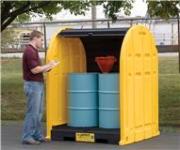A new study concludes that models may be predicting releases of atmospheric carbon dioxide that are either too high or too low, depending on the region, because they don't adequately reflect variable temperatures that can affect the amount of carbon released from soil.
Research to map the distribution of manure on the surface of feedlots and the flow of liquid manure in rain runoff could lead to both precision harvesting of manure and also precision application of manure to crop fields, while controlling nutrient losses, gas emissions, and odors.
Identifying the human impact of rising sea levels is far more complex than just looking at coastal cities on a map. Rather, estimates that are based on current, static population data can greatly misrepresent the true extent – and the pronounced variability – of the human toll of climate change, said University of Wisconsin-Madison researchers.
A technical comment published in the current edition of the journal Science casts doubt on a widely publicized study that concluded that a bacterial bloom in the Gulf of Mexico consumed the methane discharged from the Deepwater Horizon well.
A University of Sheffield professor has found a way of locking up iodine radioisotopes in a durable, solid material suitable for ultimate disposal, such as lead iodovanadinite(Pb5(VO4)3I).
Computer simulation studies by scientists at the U.S. Department of Agriculture suggests that a dairy cow living year-round in the great outdoors may leave a markedly smaller ecological hoofprint than its more sheltered sisters.
The once degraded forests in the Curacautin Valley in Chile have now recovered sufficiently, after hard work over the last decades, to be able to help provide a sustainable living to the people in the area, based on fair trade and responsible forest management principles.
Melinda Daniels, associate professor of geography, and Keith Gido, associate professor of biology, are collaborating on a project that involves habitat and fish sampling on the Kansas River, which stretches across northeast Kansas.
Certain lichens can break down the infectious proteins responsible for chronic wasting disease, a troubling neurological disease fatal to wild deer and elk and spreading throughout the United States and Canada, according to U.S. Geological Survey research published in the journal PLoS ONE.

Mitigating damage from environmental problems is a daunting task, especially considering the scope of the project. Despite the great size of the problems facing the environment, the sheer size of these issues can leave those in a position to do a little something about it feeling paralyzed. But for those used to taking on the Earth’s biggest challenges – literally oceans and mountains – pursuing relief after such disasters is all in a day’s work.
The Project Torpedalo team used Autodesk Digital Prototyping software to design, visualize and simulate the carbon fiber boat that will compete in the Woodvale Challenge Atlantic Rowing Race 2011. The race starts Dec. 4 and follows a course across the Atlantic Ocean from the Canary Islands to the finish line in Barbados.

Radionuclides in seawater have been reported from the Fukushima plant's discharge canals, from coastal waters five to 10 kilometers south of the plant, and from 30 kilometers offshore, that are at least an order of magnitude higher than the highest levels in 1986 in the Baltic and Black Seas, the two ocean water bodies closest to Chernobyl.
Nitrogen pollution in our coastal ecosystems, the result of widespread use of synthetic agricultural fertilizers and of human sewage, leads to decreased water transparency, the loss of desirable fish species, and the emergence of toxic phytoplankton species—such as the algae behind the renowned "red tides" that kill fish.
More than 400 scientists, lawmakers and the nation's top conservation leaders asked the Obama administration to set clear standards for water and wildlife protection in sweeping new rules that would apply to 193 million acres of national forest lands.
Barred owls may be more abundant in coniferous forests of the Pacific Northwest than previously recognized, according to research published in the Journal of Wildlife Management.

Ignoring EPA regulations can be costly -- and not just in terms of fines.
As concerns about air pollution from large dairies and other concentrated animal feeding operations (CAFOs) continue to mount, scientists are reporting a practice that could cut emissions of the abundant agricultural gas ammonia by up to 30 percent.
Bottlenose dolphins and beluga whales, two marine species at or near the top of their respective food webs, accumulate more chemical pollutants in their bodies when they live and feed in waters near urbanized areas.
Tests of a new antibody-based “biosensor” developed by researchers at the Virginia Institute of Marine Science show that it can detect marine pollutants like oil much faster and more cheaply than current technologies. The device is small and sturdy enough to be used from a boat.
Plants that digest toxic waste, parks built from old building materials, trees that lower utility bills and many other sustainable concepts are part of a free educational resource from the American Society of Landscape Architects.